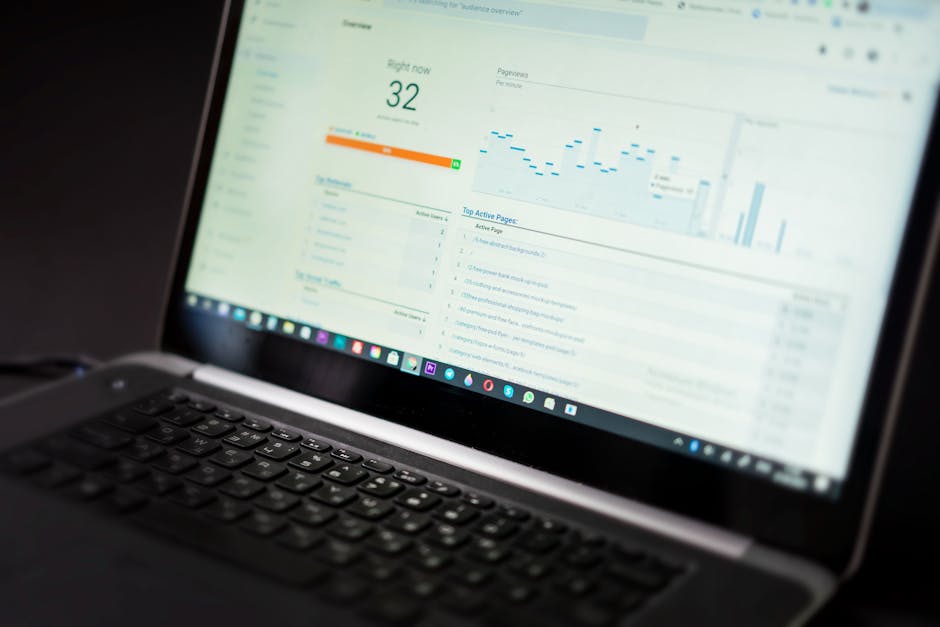Harnessing the Power of Predictive Analytics for Workplace Optimization
“Predictive analytics is revolutionizing how organizations manage their workplaces. By leveraging historical data and statistical algorithms, businesses can forecast future trends, optimize workflows, and make data-driven decisions that enhance efficiency and productivity. This article explores how predictive analytics can transform workplace management and provide competitive advantages in today's fast-paced business environment. ”

Harnessing the Power of Predictive Analytics for Workplace Optimization
In today's data-driven business landscape, organizations are constantly seeking ways to improve efficiency, reduce costs, and enhance decision-making. Predictive analytics has emerged as a powerful tool that enables businesses to transform raw data into actionable insights, helping them anticipate future trends and optimize their workplace operations.

What is Predictive Analytics?
Predictive analytics is a branch of advanced analytics that uses historical data, statistical algorithms, and machine learning techniques to identify patterns and predict future outcomes. Unlike traditional business intelligence that focuses on what has happened, predictive analytics looks forward, using past events to anticipate the future.
At its core, predictive analytics involves:
- Collecting and analyzing historical data from various sources
- Identifying patterns and relationships within the data
- Creating statistical models that can forecast future trends and behaviors
- Applying these insights to make more informed business decisions
For workplace management professionals—whether in HR, IT, facilities management, or educational institutions—predictive analytics offers tremendous potential to transform operations and create more efficient, productive environments.
The Business Value of Predictive Analytics in the Workplace
Enhanced Decision-Making
Predictive analytics empowers managers to make data-driven decisions rather than relying on intuition or past experiences alone. By analyzing historical data and identifying patterns, organizations can anticipate potential issues before they arise and take proactive measures to address them.
For example, HR managers can use predictive analytics to forecast employee turnover rates and identify factors that contribute to retention issues. This allows them to implement targeted interventions before valuable employees decide to leave, potentially saving thousands in recruitment and training costs.
Workflow Optimization
Workflow optimization is the strategic process of analyzing and refining current workflows to enhance efficiency and productivity. Predictive analytics plays a crucial role in this process by:
- Identifying bottlenecks and inefficiencies in existing processes
- Predicting resource requirements for upcoming projects
- Automating repetitive, time-consuming tasks
- Providing insights for continuous improvement
By implementing predictive analytics in workflow optimization, organizations can streamline operations, remove obstacles or redundancies, and create more efficient business processes that save time and resources.

Improved Resource Allocation
One of the most significant benefits of predictive analytics is its ability to help organizations allocate resources more effectively. By forecasting future demands and requirements, businesses can ensure they have the right resources in the right place at the right time.
Facility managers can use predictive analytics to optimize space utilization by analyzing historical usage patterns and predicting future needs. This can lead to significant cost savings by reducing unnecessary real estate expenses while ensuring employees have the appropriate spaces for their work activities.
Enhanced Customer Experience
Predictive analytics can also help organizations improve customer satisfaction by anticipating needs and resolving issues more quickly. As the saying goes, "workflow optimization is the glue that bridges customer expectations and better business processes."
With efficient workflows powered by predictive insights, teams can help more customers in less time. Customer service requests that previously took days might be resolved in hours, leading to happier customers and stronger business relationships.
Practical Applications of Predictive Analytics in Workplace Management
Facilities Management
Predictive analytics offers numerous applications in facilities management:
- Space Utilization: Analyze historical usage data to predict future space needs and optimize office layouts.
- Maintenance Scheduling: Predict equipment failures before they occur, allowing for proactive maintenance that reduces downtime and extends asset life.
- Energy Management: Forecast energy consumption patterns to identify opportunities for cost savings and sustainability improvements.
For example, a university might use predictive analytics to optimize classroom scheduling based on historical enrollment data, ensuring efficient use of campus facilities while accommodating student needs.
Human Resources
HR departments can leverage predictive analytics to:
- Talent Acquisition: Identify the most promising candidates by analyzing historical hiring data and performance metrics.
- Employee Retention: Predict which employees are at risk of leaving and implement targeted retention strategies.
- Workforce Planning: Forecast future staffing needs based on business growth projections and historical turnover rates.
A company experiencing high turnover might use predictive analytics to identify common factors among departing employees, such as specific managers, departments, or work conditions, allowing them to address the root causes rather than just the symptoms.

IT Management
IT managers can use predictive analytics to:
- System Performance: Predict potential system failures or performance issues before they impact users.
- Security Threat Detection: Identify unusual patterns that might indicate security breaches or vulnerabilities.
- Resource Allocation: Forecast computing resource needs to ensure optimal performance during peak usage periods.
For instance, a school district's IT department might use predictive analytics to anticipate when network traffic will be highest and allocate bandwidth accordingly, ensuring smooth operations during critical periods like online testing.
Implementing Predictive Analytics in Your Organization
1. Define Clear Objectives
Before implementing predictive analytics, clearly define what you want to achieve. Are you looking to optimize space utilization, improve employee retention, enhance security, or achieve other specific goals? Having clear objectives will guide your data collection and analysis efforts.
2. Assess Data Availability and Quality
Predictive analytics requires high-quality, relevant data. Assess what data you currently have available and identify any gaps that need to be filled. Consider both structured data (like spreadsheets and databases) and unstructured data (like emails and social media).
Knowledge management systems can help organize and make accessible the vast amounts of data within your organization. Effective knowledge management ensures that the right information is available for analysis when needed.
3. Choose the Right Tools and Technologies
Numerous tools are available for predictive analytics, ranging from specialized statistical software to comprehensive business intelligence platforms. Consider factors such as:
- Ease of use for your team
- Integration with existing systems
- Scalability to meet future needs
- Cost and return on investment
Popular options include Microsoft Power BI, Tableau, and various cloud-based analytics services that offer predictive capabilities.
4. Build Cross-Functional Teams
Successful predictive analytics initiatives often require collaboration across departments. Consider creating teams that include:
- Data scientists or analysts who understand statistical methods
- Subject matter experts who understand the business context
- IT professionals who can ensure data security and system integration
- Decision-makers who will act on the insights generated
This cross-functional approach ensures that technical expertise is combined with business acumen to produce actionable insights.

5. Start Small and Scale
Rather than attempting to implement predictive analytics across your entire organization at once, start with a pilot project focused on a specific challenge or opportunity. This allows you to:
- Demonstrate value quickly
- Learn and refine your approach
- Build support for broader implementation
- Identify and address potential challenges
For example, you might begin by using predictive analytics to optimize meeting room usage before expanding to comprehensive space management.
6. Ensure Data Security and Privacy
As with any data-intensive initiative, it's crucial to maintain robust data privacy and information security practices. This includes:
- Implementing appropriate access controls
- Encrypting sensitive data
- Complying with relevant regulations like GDPR or CCPA
- Being transparent with employees about how their data is used
Balancing knowledge sharing with knowledge protection is a critical challenge that requires careful consideration of factors such as the level of openness, identification of core knowledge areas, and establishment of appropriate mechanisms for knowledge transfer and collaboration.
Challenges and Considerations
Data Quality and Availability
The effectiveness of predictive analytics depends heavily on the quality and completeness of the data used. Organizations often face challenges with:
- Siloed data spread across different systems
- Inconsistent data formats and definitions
- Missing or inaccurate data points
- Limited historical data for new initiatives
Investing in data integration and cleansing tools can help address these challenges and improve the reliability of predictive models.
Skills and Expertise
Implementing predictive analytics requires specialized skills that may not be readily available within your organization. Consider options such as:
- Training existing staff in analytics techniques
- Hiring data scientists or analysts
- Partnering with external consultants or service providers
- Using user-friendly analytics tools designed for business users
The right approach will depend on your organization's size, resources, and specific needs.
Change Management
Perhaps the most significant challenge in implementing predictive analytics is managing the organizational change it requires. Employees may be resistant to data-driven decision-making if they're accustomed to relying on experience and intuition.
Effective change management strategies include:
- Communicating the benefits of predictive analytics clearly
- Involving stakeholders in the implementation process
- Providing training and support for users
- Celebrating early wins to build momentum
By addressing these human factors, you can increase the likelihood of successful adoption and maximize the value of your predictive analytics initiatives.
The Future of Predictive Analytics in Workplace Management
As technology continues to evolve, we can expect predictive analytics to become even more powerful and accessible. Some emerging trends include:
- AI and Machine Learning Integration: More sophisticated algorithms that can identify complex patterns and make increasingly accurate predictions.
- Real-time Analytics: The ability to analyze data and generate insights in real-time, enabling immediate responses to changing conditions.
- Enhanced Visualization Tools: More intuitive ways to present predictive insights, making them accessible to non-technical users.
- IoT Integration: Incorporating data from Internet of Things devices to provide richer insights into workplace operations.
Organizations that embrace these advances will be well-positioned to create more efficient, productive, and responsive workplaces.
Conclusion
Predictive analytics represents a powerful tool for workplace optimization, enabling organizations to move beyond reactive approaches to proactive management of their facilities, resources, and people. By leveraging historical data to anticipate future needs and challenges, businesses can make more informed decisions, optimize workflows, and create environments that support both organizational goals and employee needs.
While implementing predictive analytics does present challenges, the potential benefits—including enhanced efficiency, reduced costs, and improved decision-making—make it a worthwhile investment for forward-thinking organizations. By starting with clear objectives, ensuring data quality, building the right team, and addressing change management needs, you can successfully harness the power of predictive analytics to transform your workplace.
As we move into an increasingly data-driven future, the organizations that most effectively use predictive analytics to optimize their workplaces will gain significant competitive advantages. The time to begin that journey is now.